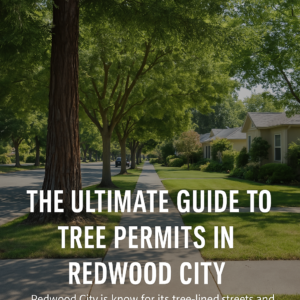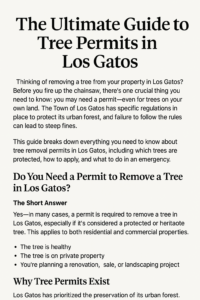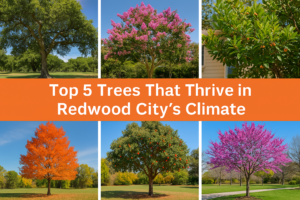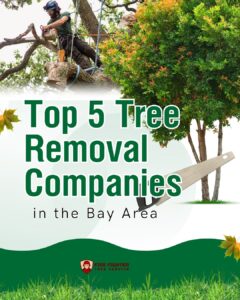Trees, like humans and animals, are susceptible to diseases. From fungal infections to root rot, these diseases can spread rapidly, compromising entire ecosystems.
In 2021, there was an outbreak of tree dieback in East Bay hills and Peninsula. Before your yard is a victim, it is important to know common tree diseases in the Bay Area and preventive measures.
Table of Contents
- Introduction to Tree Diseases in the Bay Area
- Top Common Tree Diseases in the Bay Area
- Prevention Tips for Tree Diseases
- When to Call a Professional Arborist
Introduction to Tree Diseases in the Bay Area
Maintaining healthy trees is crucial for property owners and managers. Bay Area tree diseases can spread through direct contact with infected trees, insects, water, air, or soil. Climate changes, soil conditions, and extreme weather patterns like prolonged drought increase the trees’ vulnerability to diseases.
A single diseased tree can compromise the entire neighborhood ecosystem. So, knowledge of common tree health issues is crucial for property owners and managers to maintain healthy urban forests. Learn about prevalent tree diseases in the Bay Area and proactive ways to prevent tree infections in this in-depth article.
Top Common Tree Diseases in the Bay Area
1. Sudden Oak Death

The sudden oak death is a tree fungus-like infection caused by the invasive plant pathogen Phytophthora ramorum. The disease is prevalent in all 19 counties in the Bay Area. Apart from oaks, the oocytes infect non-oak species.
Trees with compromised tree barks due to pruning, insect damage, or other mechanical damage are the most vulnerable to an infestation. The oocytes form cankers that grow and spread, disrupting water and nutrient movement by girdling the trunk or branches once inside the tree. The tree then dies slowly as the cankers take over its vascular system.
Symptoms
Signs of a tree infected with the Phytophthora ramorum depend on the tree species. Sudden browning of leaves without a period of rapid decline occurs in many oak tree species. Leaf browning manifests two years after disease infestation on the tree’s trunk.
The disease gets its name from this browning because the tree appears healthy until the leaves change color. If you notice olive green, pale green, or yellow-green leaves, it could be a sudden oak death attack.
The red oaks develop bark canker, presenting as a viscous, sticky sap oozing out of the tree’s bark. The sap can be burgundy, black, or amber-orange and smells like a wine barrel. Apart from that, the sap kills mosses and lichens growing on the tree’s bark.
Removing the bark of the canker shows discolored brown infected tissue with black line zones separating the infected area from healthy tree tissue. The Canyon live oak also develops lesions on its twigs.
Phytophthora Prevention and Treatment
There is no known cure for sudden oak death. Management strategies focus on preventing the initial pathogen infection and subsequent spread. Prevention strategies include:
- Inspect oak tree species nurseries for the pathogen before planting.
- Infected trees with compromised structural integrity are hazardous because of unexpected limb and trunk breakage. Carefully prune branches about to break off.
- Work with a certified arborist to remove the tree if it lacks structural support.
- Chip the removed branches and trunk on site and burn them. Moving the infected pieces may spread the pathogen to other plants.
2. Anthracnose

Anthracnose diseases are a group of fungal infections that cause dark lesions on the leaves and twigs of sycamores, maples, and oaks. In severe cases, the fungus may cause sunken cankers and lesions on twigs. The fungus also infects turfgrass in some Bay Area regions.
The disease starts in the leaves and twigs, earning its common name leaf, twig, or shoot blight. It affects deciduous and evergreen trees, plants, vegetables, fruits, and flowers. Several species of fungi cause Anthracnose disease. The diagnosis is positive if the fungus produces spores in a fruiting body called acervulus. The fungus requires water to spread and infect.
Anthracnose diseases defoliate trees from the ground up. Leaves turn brown and curl as sections begin to die. Oaks and sycamore tree leaves develop brown, black, or beige spots, which later extend on the twigs. The lesions appear irregularly on maple trees and along the leaf veins on sycamore and oak trees.
Anthracnose Treatment and Prevention
Fungicides are the first line of defense if your tree tests are positive for Anthracnose diseases. Nevertheless, the best approach is to prevent the disease because it is challenging to control the infection once it occurs. You can also remove the affected trees, especially if the trees are too close to each other.
The fungus spreads during wet springs. It is also prone in regularly irrigated areas where watering reaches foliage. Avoid targeting the leaves when watering your greenery. You can also use preventative pesticides like Modesto ash to tame the disease.
3. Armillaria Root Rot

The Armillaria root rot, mushroom root rot, or oak root fungus is a soil-borne fungus that attacks decaying roots of plants and trees. Its action on decomposing roots is essential for ecological balance. However, the fungus attacks live root tissue in distressed or declining trees.
Armillaria root rot is endemic to California’s woody plants. The fungus thrives in former woodland soils undergoing urban development. Trees in former riverbeds, floodplains, streambeds, or near creeks are vulnerable to the fungus. These areas are prone to dead decaying roots infested with the fungus, which can stay dormant for years. The oak and maple trees are the most susceptible hosts.
The fungus uses moisture from the soil to spread its spores to surrounding tree roots. The fungus can survive for years on dead and living roots and fruit. Nut, ornamental, and native tree species can harbor the fungus for long periods as well.
The fungus invades the lateral and the crown region of the root system, destroying the roots. Its white fungal colonies spread in the cambium region of the tree, which is between the bark and the wood. Armillaria symptoms include stunted growth or dieback of shoots, small yellowing leaves, and premature leaf drop.
Root Rot Prevention
The first step toward preventing the Armillaria root rot fungus is improving drainage and soil aeration around urban trees. The fungus does not spread in dry soil.
Remove infested trees, ensuring they are removed from the top to the roots. Dry the tree thoroughly before disposal. Remove surrounding healthy-looking trees from the infected tree because the probability of the fungus invasion to surrounding tree root systems is high.
Prevention Tips for Tree Diseases
Healthy tree maintenance is crucial to preventing the development and spread of tree diseases. Bay Area arborists adviseon regular tree management practices under the guidance of a certified tree care specialist. Here are tried and tested tree disease prevention tips to help maintain healthy trees on your property.
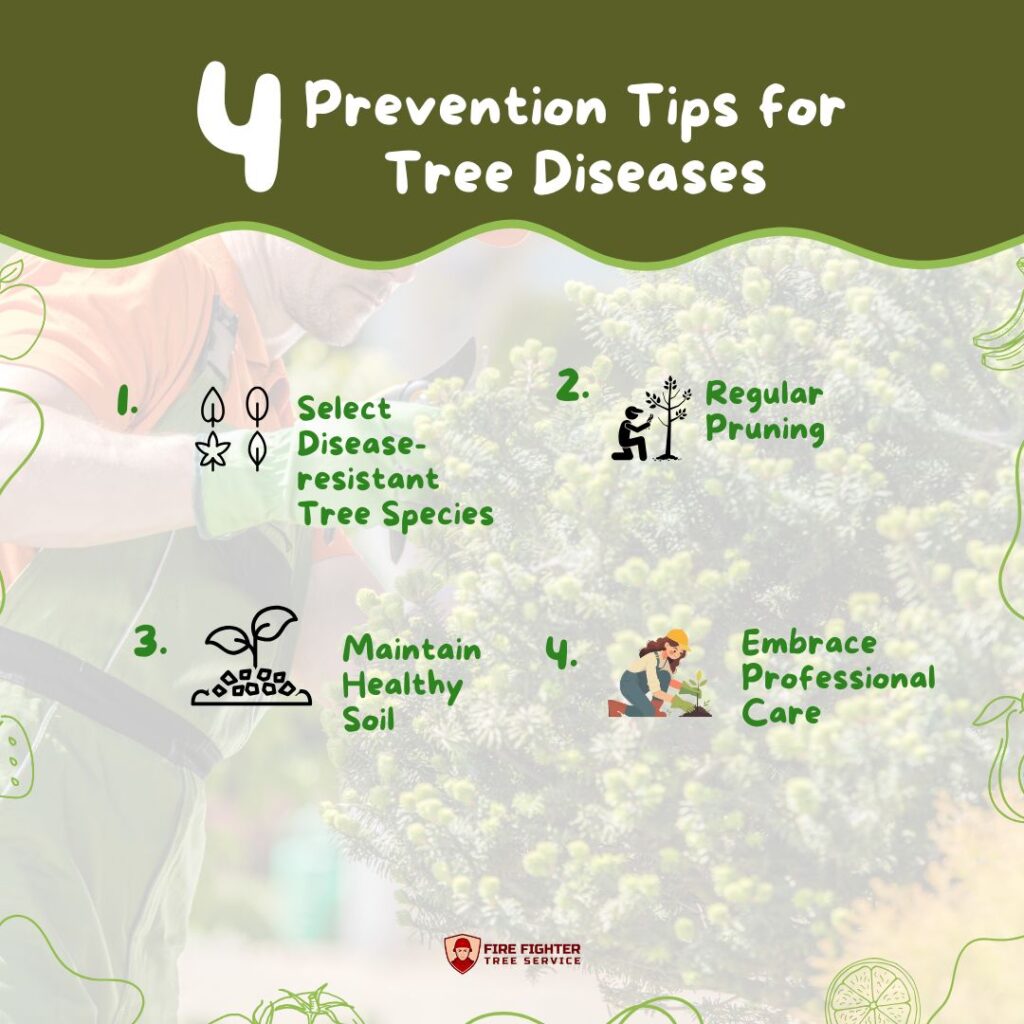
1. Select Disease-resistant Tree Species
Disease spread suppression requires deliberate action. A disease-resistant tree is the best place to start. Disease-resistant trees prevent the initial infection, breaking the transmission cycle. The trees’ resistance reduces disease severity, reducing the amount of transmissible infectious material. Some disease-resistant tree species can reduce the pathogen population, suppressing the disease.
2. Regular Pruning
Pruning is a maintenance approach that helps you eliminate compromised sections of the tree early. Safely dispose of the diseased pieces to remove transmissible fungal spores and bacteria. Pruning removes excess foliage that builds moisture, a medium for pathogens to spread and grow. Crown reduction maintains the structural integrity of the tree by removing excess weight.
3. Maintain Healthy Soil
Fungus, bacteria, and parasites thrive in moist soil. Ensure the soil around the trees has proper drainage to eliminate waterlogging, which is a breeding ground for pathogen overgrowth.
Mind soil nutrition. Nutritional imbalances weaken the tree, making it incapable of withstanding diseases. Maintain soil pH to favor the growth of your tree species. An acidic or alkaline pH can favor the spread of pathogens or stunt the tree’s growth, increasing its susceptibility to infection.
4. Embrace Professional Care
Hiring a tree care specialist is the best solution for the health of your trees. A certified arborist has extensive knowledge of tree diseases and care solutions. Arborist services include regular inspections and interventions, enabling early disease detection. Utilize the tree care master’s resources, expertise, and experience to nurture your trees to health and prevent diseases.
When to Call a Professional Arborist
Without tree knowledge, it is challenging to detect tree diseases until it is too late. For instance, the sudden oak death disease takes years before physical symptoms manifest. The tree’s health is usually irredeemably compromised by the time symptoms show. Working with a certified arborist in tree disease care is vital for early detection and treatment.
Leverage the local knowledge of Bay Area’s certified tree care specialists for professional tree health services tailored for the region. The arborist knows diseases endemic to the Bay Area and effective strategies to curb the spread and safely eliminate the problem.

